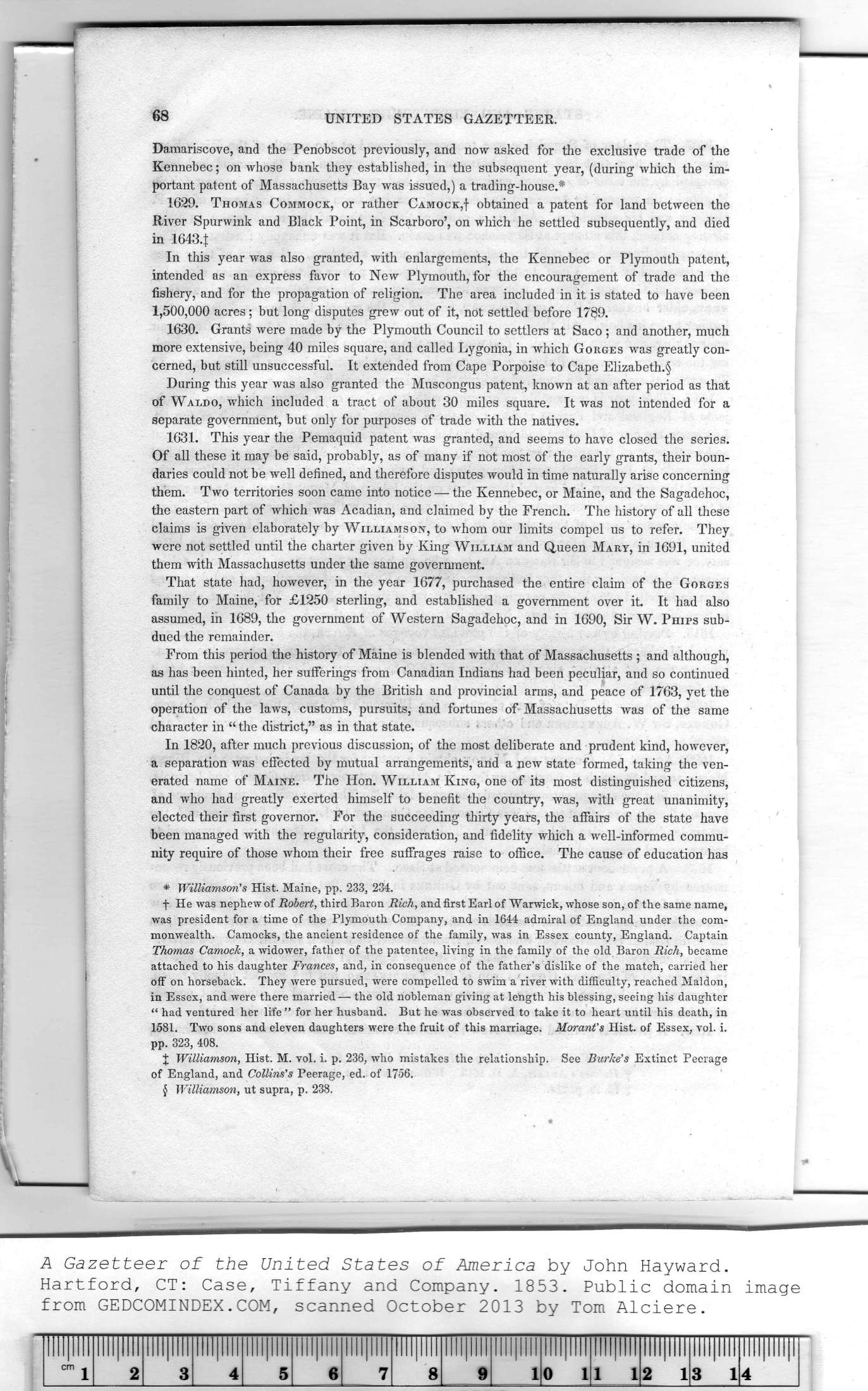Click on the image for a larger version suitable for printing. HOME PAGE ... REFERENCE PAGE ...THIS GAZETTEER’S PAGE |
 |
|
Note: Ctrl and + increases the font size of the text below, Ctrl and - decreases it, and Ctrl and 0 resets it to default size. 68 UNITED STATES GAZETTEER. [ Damariscove, and the Penobscot previously, and now asked for the exclusive trade of the I Kennebec; on whose bank they established, in the subsequent year, (during which the im- portant patent of Massachusetts Bay was issued,) a trading-house.* 1629. Thomas Commock, or rather CAMOCK,f obtained a patent for land between the , in 16434 f In this year was also granted, with enlargements, the Kennebec or Plymouth patent, I intended as an express favor to New Plymouth, for the encouragement of trade and the j fishery, and for the propagation of religion. The area included in it is stated to have been 1,500,000 acres; but long disputes grew out of it, not settled before 1789. 1 1630. Grants were made by the Plymouth Council to settlers at Saco ; and another, much I more extensive, being 40 miles square, and called Lygonia, in which Gorges was greatly con- | i cerned, but still unsuccessful. It extended from Cape Porpoise to Cape Elizabeth.§ 1 During this year was also granted the Museongus patent, known at an after period as that S of Waldo, which included a tract of about 30 miles square. It was not intended for a j ! separate government, but only for purposes of trade with the natives. i | 1631. This year the Pemaquid patent was granted, and seems to have closed the series. ! j Of all these it may be said, probably, as of many if not most of the early grants, their boun- ; : daries could not be well defined, and therefore disputes would in time naturally arise concerning | j them. Two territories soon came into notice — the Kennebec, or Maine, and the Sagadehoc, ! the eastern part of which was Acadian, and claimed by the French. The history of all these j claims is given elaborately by Williamson, to whom our limits compel us to refer. They ' were not settled until the charter given by King William and Queen Mary, in 1691, united ■ them with Massachusetts under the same government. ; That state had, however, in the year 1677, purchased the entire claim of the Gorges ) family to Maine, for £1250 sterling, and established a government over it. It had also i assumed, in 1689, the government of Western Sagadehoc, and in 1690, Sir W. Phips sub- dued the remainder. From this period the history of Maine is blended with that of Massachusetts ; and although, until the conquest of Canada by the British and provincial arms, and peace of 1763, yet the ( ; character in “ the district," as in that state. I In 1820, after much previous discussion, of the most deliberate and prudent kind, however, J a separation was effected by mutual arrangements, and a new state formed, taking the ven- j erated name of Maine. The Hon. William King, one of its most distinguished citizens, and who had greatly exerted himself to benefit the country, was, with great unanimity, I * Williamson's Hist. Maine, pp. 233, 234. , f He was nephew of Robert, third Baron Rich, and first Earl of Warwick, whose son, of the same name, i was president for a time of the Plymouth Company, and in 1644 admiral of England under the com- 1 monwealth. Camocks, the ancient residence of the family, was in Essex county, England. Captain Thomas Camock, a widower, father of the patentee, living in the family of the old Baron Rich, became , ! off on horseback. They were pursued, were compelled to swim a river with difficulty, reached Maldon, in Essex, and were there married — the old nobleman giving at length his blessing, seeing his daughter “ had ventured her life " for her husband. But he was observed to take it to heart until his death, in j 1581. Two sons and eleven daughters were the fruit of this marriage. Morant's Hist, of Essex, vol. i. pp. 323, 408. . J Williamson, Hist. M. vol. i. p, 236, who mistakes the relationship. See Burke's Extinct Peerage of England, and Collins's Peerage, ed. of 1756. § Williamson, ut supra, p. 238. A Gazetteer of the United States of America by John Hayward. Hartford, CT: Case, Tiffany and Company. 1853. Public domain |